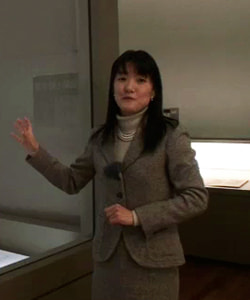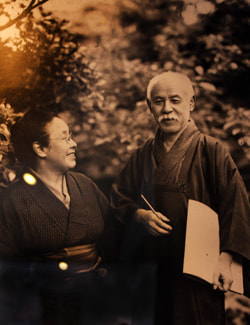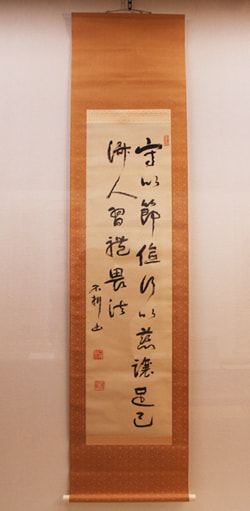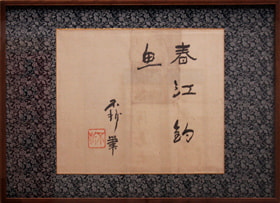
Touko Nabeshima, a researcher of the Calligraphy Museum
We talked with Touko Nabeshima, a researcher of the Calligraphy Museum.
Q : Fusetsu Nakamura is especially famous as a Western-style painter. What kind of person was he?
Nabeshima: Although Fusetsu was born in Tokyo, his family was evacuated to Nagano Prefecture, where his family had originated, when he was five years old in order to escape the confusion of the Meiji Restoration, and he spent his childhood and adolescence in Nagano Prefecture until the age of 23. Since he loved painting from an early age, he looked at Hiroshige's Ukiyo-e series as if they were picture books, and enjoyed copying those series of Ukiyo-e. His lived a hard life in Nagano, and could not attend a school as much as he wanted. He made time to study Chinese classics, mathematics, Nanga-style painting and calligraphy from teachers in the neighborhood while working as a shop-boy at a kimono shop and as a pastry cook. Since he was especially good at painting and mathematics in those days, he wanted to become a painter or mathematics teacher in the future. Later, he got a job as an assistant teacher when he was 19 years old. Then, he taught at an elementary school as a drawing and manual arts teacher. One of his students at the elementary school was Shunso Hishida, who later became a successful Japanese-style painter. Fusetsu appreciated Shunso's talent for painting, and encouraged him to become a painter. Then, Fusetsu himself planed to move to Tokyo and become a Western-style painter. In his autobiography, he wrote that when he stood at the crossroads of his life, he wondered whether he would pursue the road to art or become a mathematician. If he chose to become a mathematician, he would spend a different life. However, he gave up being a mathematician because he had hearing difficulties and thought that a mathematician should be proficient at foreign languages. Therefore he chose the road to art. (leading to the bottom)
In this way, Fusetsu began to make illustrations, which opened up a new field for him, and exchanges between Fesetsu and Shiki started. Although Shiki died in 1902 and they had known each other for a short period of time, Fesetsu, as an illustrator for the newspaper, met Shiki almost everyday and the time they spent together was very meaningful.
During the Sino-Japanese War, Shiki and Fusetsu went to China as a war correspondent and as a military painter respectively. However, a cease-fire took place in their destination, so they lost their jobs as war correspondents. They unexpectedly had enough idle time during the cease-fire period, and traveled around China and the Korean Peninsula because, in part, Shiki made an offer to do so. During the travel, Fusetsu witnessed ancient Chinese items, and awakened to the importance of Chinese history, culture and ancient documents and decided to study them. He actually went to Chine, and breathed an atmosphere in the continent. It is certain that the experience had a great impact on him. After that, Fusetsu started collecting ancient Chinese antiquities. Even at that point, Fusetsu could take the excursion after being asked by Shiki, so it can be said that Fusetsu could work his way up by Shiki's support, which was occasionally provided at some stages of Fusetsu's life. Although Shiki returned to Japan earlier than Fusetsu, Fusetsu continued traveling around China and the Korean Peninsula for six months. During his trip, he made drawings, and obtained ancient rubbed copies as much as he could carry on. Although it was the only occasion he went to China, he frequently visited antiquarian bookstores after returning to Japan, and immediately bought ancient books if he had an interest in them. Also, Chinese merchants visited his house to offer ancient Chinese items. He sent someone to China to buy items if he wanted them. These items became a collection of Calligraphy Museum. (leading to the bottom)
We talked with Touko Nabeshima, a researcher of the Calligraphy Museum.
Q : Fusetsu Nakamura is especially famous as a Western-style painter. What kind of person was he?
Nabeshima: Although Fusetsu was born in Tokyo, his family was evacuated to Nagano Prefecture, where his family had originated, when he was five years old in order to escape the confusion of the Meiji Restoration, and he spent his childhood and adolescence in Nagano Prefecture until the age of 23. Since he loved painting from an early age, he looked at Hiroshige's Ukiyo-e series as if they were picture books, and enjoyed copying those series of Ukiyo-e. His lived a hard life in Nagano, and could not attend a school as much as he wanted. He made time to study Chinese classics, mathematics, Nanga-style painting and calligraphy from teachers in the neighborhood while working as a shop-boy at a kimono shop and as a pastry cook. Since he was especially good at painting and mathematics in those days, he wanted to become a painter or mathematics teacher in the future. Later, he got a job as an assistant teacher when he was 19 years old. Then, he taught at an elementary school as a drawing and manual arts teacher. One of his students at the elementary school was Shunso Hishida, who later became a successful Japanese-style painter. Fusetsu appreciated Shunso's talent for painting, and encouraged him to become a painter. Then, Fusetsu himself planed to move to Tokyo and become a Western-style painter. In his autobiography, he wrote that when he stood at the crossroads of his life, he wondered whether he would pursue the road to art or become a mathematician. If he chose to become a mathematician, he would spend a different life. However, he gave up being a mathematician because he had hearing difficulties and thought that a mathematician should be proficient at foreign languages. Therefore he chose the road to art.
Q : How did he become a successful Western-style painter, and what made him devote himself to calligraphy?
When he was an elementary school teacher, he steadily piled up savings and waited for a chance to move to Tokyo. Then, he found an advertisement in a newspaper, which indicated that Juichi-kai (later called Fudosha), an art school organized by Western-style painter Shotaro Koyama, would accept students. He made up his mind, and resigned his job as a teacher, and then, at last achieved his desire of moving to Tokyo. It was his first step to being a Western-style painter. When he was a student of Shotaro Koyama, he focused on studying "Road and Landscape," a pencil drawing technique, in which a road stretching in the middle and buildings and trees on the both sides of the road are drawn in a picture plane. Then, he studied watercolor painting, and exhibited his works at "Meiji Bijutsu-kai" exhibitions. After that, he was finally allowed to create oil painting. In this way, he gradually became known as a Western-style painter in Meiji Bijutsu-kai and Japan. Although Western-style painting was his lifework, he enjoyed creating Nanga-style and Japanese-style paintings since his childhood, so he did not stick to Western-style painting only. He pursued his career as a Western-style painter while having interest in Japanese-style painting and calligraphy.
Then, he met Shiki Masaoka in 1894. At that time, Shiki was a chief editor at the newspaper "Shonihon (later called ’Nihon’)." Shiki thought that some relaxing illustrations made the newspaper more attractive because the newspaper was totally filled with texts. Shiki met Fusetsu through painter Chu Asai, and saw Fusetsu's paintings. He immediately decided to use Fusetsu's illustrations for the newspaper. Fusetsu studied painting from Asai when he attended Fudosha.After that, they worked together to produce panorama paintings and others. Asai knew Fusetsu's ability to paint, so he introduced Fesetsu to Shiki.
A letter of Shiki Masaoka,"Shiki Koji Sekitoku", 1898
Shiki Masaoka(1867-1902) requested to draw a seasonable llustration again becasue Fusetsu's illustration unfit the season of the publishing.


Shiki wrote the state flower of tampala bow in the first half of the letter, which seems to be what it is thinking. And he wrote a flower may scatter for the turn of the seasons, It is associated that he was unwilling to request a new work once again. For that reason, the character is a little smallish.
Q. How did he become a successful Western-style painter, and what made him devote himself to calligraphy?
When he was an elementary school teacher, he steadily piled up savings and waited for a chance to move to Tokyo. Then, he found an advertisement in a newspaper, which indicated that Juichi-kai (later called Fudosha), an art school organized by Western-style painter Shotaro Koyama, would accept students. He made up his mind, and resigned his job as a teacher, and then, at last achieved his desire of moving to Tokyo. It was his first step to being a Western-style painter. When he was a student of Shotaro Koyama, he focused on studying "Road and Landscape," a pencil drawing technique, in which a road stretching in the middle and buildings and trees on the both sides of the road are drawn in a picture plane. Then, he studied watercolor painting, and exhibited his works at "Meiji Bijutsu-kai" exhibitions. After that, he was finally allowed to create oil painting. In this way, he gradually became known as a Western-style painter in Meiji Bijutsu-kai and Japan. Although Western-style painting was his lifework, he enjoyed creating Nanga-style and Japanese-style paintings since his childhood, so he did not stick to Western-style painting only. He pursued his career as a Western-style painter while having interest in Japanese-style painting and calligraphy.
Then, he met Shiki Masaoka in 1894. At that time, Shiki was a chief editor at the newspaper "Shonihon (later called ’Nihon’)." Shiki thought that some relaxing illustrations made the newspaper more attractive because the newspaper was totally filled with texts. Shiki met Fusetsu through painter Chu Asai, and saw Fusetsu's paintings. He immediately decided to use Fusetsu's illustrations for the newspaper. Fusetsu studied painting from Asai when he attended Fudosha.After that, they worked together to produce panorama paintings and others. Asai knew Fusetsu's ability to paint, so he introduced Fesetsu to Shiki. (Continued on top right)
Since he resumed his work as a Western-style painter, and also continued working as a newspaper illustrator after returning to Japan, he gained higher recognition as a painter, and began to receive job offers from great writers in the Meiji Period, who wanted use his illustrations for their books. He made illustrations for best known works of Toson Shimazaki, Soseki Natsume and Sachio Ito. He continued creating oil paintings as his main occupation, and eagerly displayed his oil paintings at exhibitions.
Q : Fusetsu belonged to Taiheiyo Gakai. How was he evaluated as a painter? He studied at Raphael Collin's famous school in Paris. Why did Fusetsu choose the school?
Fusetsu continued to create historical paintings under the theme of Eastern historical events until his advanced age while being a member of Taiheiyo Gakai. His historical paintings may be difficult to understand considering the trend of the times, and his successor did not exist. Therefore, it may cast a negative impact on his reputation as a painter. The reason why he continued painting may be that he was taught by Jean-Paul Laurens, who was called "the last historical painter," when he stayed in Paris. I think Laurens' teachings significantly affected him. He may want give something back to Laurens. Also, Fusetsu himself actually visited China and Korea, and admired East Asian culture, which may be one of the biggest reasons he continued to handle Eastern themes.
In the Meiji Period, as with Seiki Kuroda, everybody went to Paris and burnished their reputations. It was honor for painters at that time, so Fusetsu also studied in Paris. At that time, Chu Asai, Eisaku Wada and Saburosuke Okada stayed in Paris. Fusetsu was first taught by Raphael Collin after Chu Asai introduced Fusetsu to Collin. However, it seemed that Collin's style did not suit Fusetsu, so he transferred to Jean-Paul Laurens' school through the introduction of Takeshiro Kanokogi. During 4 years of his study in Paris, he attended Collin's school for less than a year, and was taught by Laurens for the rest of years.(continued in the next page)
In this way, Fusetsu began to make illustrations, which opened up a new field for him, and exchanges between Fesetsu and Shiki started. Although Shiki died in 1902 and they had known each other for a short period of time, Fesetsu, as an illustrator for the newspaper, met Shiki almost everyday and the time they spent together was very meaningful.
During the Sino-Japanese War, Shiki and Fusetsu went to China as a war correspondent and as a military painter respectively. However, a cease-fire took place in their destination, so they lost their jobs as war correspondents. They unexpectedly had enough idle time during the cease-fire period, and traveled around China and the Korean Peninsula because, in part, Shiki made an offer to do so. During the travel, Fusetsu witnessed ancient Chinese items, and awakened to the importance of Chinese history, culture and ancient documents and decided to study them. He actually went to Chine, and breathed an atmosphere in the continent. It is certain that the experience had a great impact on him. After that, Fusetsu started collecting ancient Chinese antiquities. Even at that point, Fusetsu could take the excursion after being asked by Shiki, so it can be said that Fusetsu could work his way up by Shiki's support, which was occasionally provided at some stages of Fusetsu's life. Although Shiki returned to Japan earlier than Fusetsu, Fusetsu continued traveling around China and the Korean Peninsula for six months. During his trip, he made drawings, and obtained ancient rubbed copies as much as he could carry on. Although it was the only occasion he went to China, he frequently visited antiquarian bookstores after returning to Japan, and immediately bought ancient books if he had an interest in them. Also, Chinese merchants visited his house to offer ancient Chinese items. He sent someone to China to buy items if he wanted them. These items became a collection of Calligraphy Museum.
Since he resumed his work as a Western-style painter, and also continued working as a newspaper illustrator after returning to Japan, he gained higher recognition as a painter, and began to receive job offers from great writers in the Meiji Period, who wanted use his illustrations for their books. He made illustrations for best known works of Toson Shimazaki, Soseki Natsume and Sachio Ito. He continued creating oil paintings as his main occupation, and eagerly displayed his oil paintings at exhibitions.
Q : Fusetsu belonged to Taiheiyo Gakai. How was he evaluated as a painter? He studied at Raphael Collin's famous school in Paris. Why did Fusetsu choose the school?
Fusetsu continued to create historical paintings under the theme of Eastern historical events until his advanced age while being a member of Taiheiyo Gakai. His historical paintings may be difficult to understand considering the trend of the times, and his successor did not exist. Therefore, it may cast a negative impact on his reputation as a painter. The reason why he continued painting may be that he was taught by Jean-Paul Laurens, who was called "the last historical painter," when he stayed in Paris. I think Laurens' teachings significantly affected him. He may want give something back to Laurens. Also, Fusetsu himself actually visited China and Korea, and admired East Asian culture, which may be one of the biggest reasons he continued to handle Eastern themes.
In the Meiji Period, as with Seiki Kuroda, everybody went to Paris and burnished their reputations. It was honor for painters at that time, so Fusetsu also studied in Paris. At that time, Chu Asai, Eisaku Wada and Saburosuke Okada stayed in Paris. Fusetsu was first taught by Raphael Collin after Chu Asai introduced Fusetsu to Collin. However, it seemed that Collin's style did not suit Fusetsu, so he transferred to Jean-Paul Laurens' school through the introduction of Takeshiro Kanokogi. During 4 years of his study in Paris, he attended Collin's school for less than a year, and was taught by Laurens for the rest of years. (continued in the next page)

Mr. and Mrs. Fusetsu Nakamura of past days

A tablet of gyosho four letters, "Shunkou-chingyo"

A hanging scroll of the sosho poem of four words, "Ka-kun (motto)"

Touko Nabeshima, a researcher of the Calligraphy Museum

Mr. and Mrs. Fusetsu Nakamura of past days

A hanging scroll of the sosho poem of four words, "Ka-kun (motto)"

A tablet of gyosho four letters, "Shunkou-chingyo"











